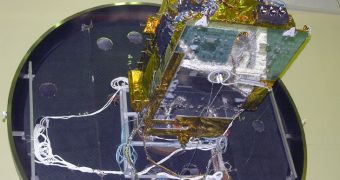Officials at the European Space Agency (ESA) announce that their telecommunications satellite Hylas has just successfully completed a new battery of tests. The assessments were of critical importance for the mission, given that satellite is scheduled for launch later this year. Only a few final overviews remain to be carried out, before the spacecraft is shipped out to French Guiana. It will most likely take-off aboard an Ariane 5 heavy-lift delivery system, although mission planners have yet to decide whether to use this rocket, or a three-stage Soyuz-2 booster.
The mission will launch from the Kourou Spaceport, which ESA operates south of the Equator. This allows access to some of the best insertion points possible from the surface of the planet. According to ESA, the new communications satellite will be shipped out no later than August, if the instrument manages to successfully pass all of its remaining reviews.
“The on-schedule completion of thermal vacuum testing is a significant milestone. In just four years from contract signature, we have completed the development and qualification of our advanced communication payload technologies. We have now demonstrated the full range of required performance in a simulated orbital environment – this enables us to move towards the launch campaign with great confidence,” says the ESA Hylas Project Manager, Andrea Cotellessa. Thermal-vacuum testing was only completed in mid-May, in Bangalore, India. The Indian Space Research Organization (ISRO) also plays a significant part in this new project.
“For Hylas, [the thermal tests] involved taking the complete satellite between the temperature extremes it will experience in orbit several times over a period of four weeks. The test confirms the overall performance and build quality of the satellite subsystems. Hylas, a public-private partnership between ESA and Avanti Communications (UK), will target the high demand for broadband services in Europe that cannot be met by terrestrial networks. It will provide capacity to serve hundreds of thousands of Internet users and broadcast up to 30 standard or 15 high-definition TV channels,” ESA officials say.
“ESA and Avanti signed the contract in 2006 for the development of Hylas, supporting the most innovative elements of this new system. The satellite is designed to have a lifetime of 15 years, and will be launched into a geostationary orbit at 33.5°W,” they conclude.

 14 DAY TRIAL //
14 DAY TRIAL //